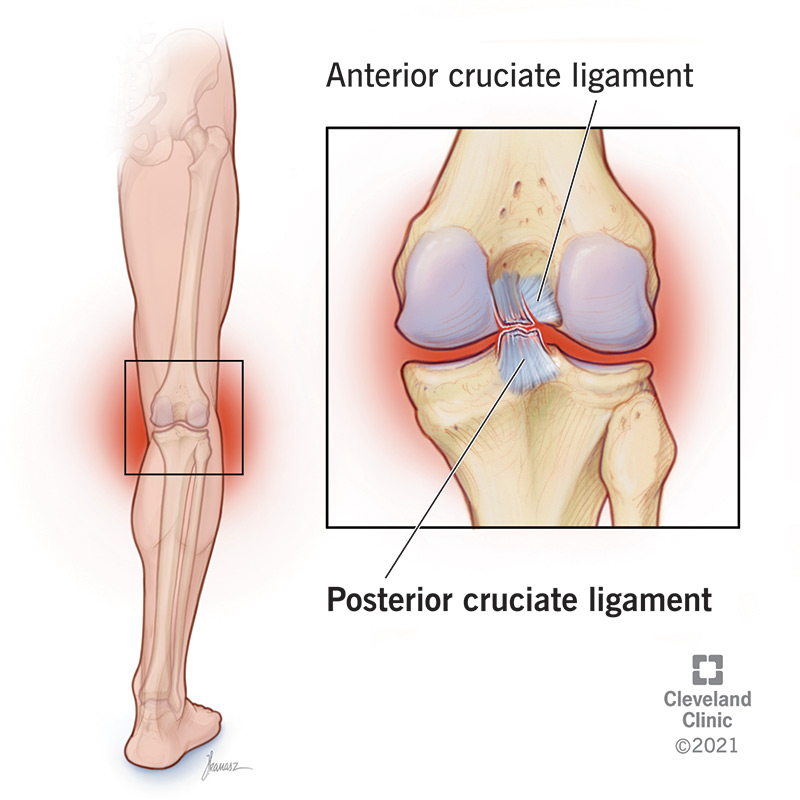The posterior cruciate ligament (PCL) connects your upper leg to your lower leg. Even though your PCL is stronger and larger than your anterior cruciate ligament (ACL), it can still be injured. People with a PCL injury may have pain, swelling and other symptoms. Treatments include both non-surgical and surgical options.
Advertisement
Cleveland Clinic is a non-profit academic medical center. Advertising on our site helps support our mission. We do not endorse non-Cleveland Clinic products or services. Policy

Your posterior cruciate ligament (PCL) runs along the back of your knee and connects your thighbone to the top of your lower leg bone. This ligament keeps your bones in place and helps your knee move smoothly. When the PCL is sprained or torn, it’s called a posterior cruciate ligament injury.
Advertisement
Cleveland Clinic is a non-profit academic medical center. Advertising on our site helps support our mission. We do not endorse non-Cleveland Clinic products or services. Policy
Posterior cruciate ligament injuries can happen to anyone, but they’re especially common among skiers and athletes who play baseball, football or soccer.
Posterior cruciate ligament injuries are far less common than ACL (anterior cruciate ligament) tears. In fact, PCL injuries make up less than 20% of all knee ligament injuries. Most commonly, PCL tears occur with other ligament injuries. Isolated PCL tears are even less common.
A PCL injury can cause mild, moderate or severe damage. Healthcare providers rate posterior cruciate ligament injuries in four different categories:
People with posterior cruciate ligament injuries may have short- or long-term symptoms. Typically, long-term symptoms occur when an injury slowly develops over time.
It depends. In mild cases, people may still be able to walk and their symptoms may be less noticeable. However, many people have difficulty walking after a PCL injury — especially if the damage is severe.
Advertisement
Generally, yes. Pain is one of the leading symptoms of a torn PCL. Discomfort may be mild or severe.
In most cases, pediatric PCL injuries can be treated with non-surgical methods. However, if your child’s PCL injury is severe, surgical options may be explored.
PCL injuries usually occur with severe knee trauma. You may develop a problem with your PCL if you:
What are the symptoms of a posterior cruciate ligament injury?
People with PCL injuries may experience a wide range of symptoms, including:
Your healthcare provider will examine your knee, check your range of motion and ask about your symptoms. They may also request imaging tests to determine the extent of damage. These tests may include:
It depends on the severity of your PCL injury. Common posterior cruciate ligament treatments include:
Though complications are rare, there are certain risks associated with knee arthroscopy. These include:
Recovery time can vary from person to person. If your injury is mild, it may only take about 10 days to heal. If you’ve had surgery to repair your PCL, recovery could take about six to nine months.
If you’ve injured your PCL, there are ways to ease discomfort and promote healing. Recommendations include:
Advertisement
If your PCL injury is minor, you may heal without complications. However, if the ligament sustained severe damage, your knee could become weak and prone to re-injury unless you have surgery.
People who undergo PCL surgery generally notice improved stability and mobility following recovery. Keep in mind, however, you may still need to wear a knee brace during physical activities to protect your joint.
If you have a sedentary office job, you’ll be able to return to work rather quickly. However, if you have a job that requires physical exertion, such as lifting, you’ll need a few more weeks to recover. Ask your healthcare provider when you can return to work or school after your PCL injury.
It can be difficult to prevent PCL injuries altogether. However, there are several things you can do to reduce your risk:
Prompt medical attention is necessary after a serious PCL injury. You should contact your healthcare provider if:
Advertisement
If you are exhibiting any of these symptoms, seek care immediately. Your medical team can determine the cause of your knee pain and design a treatment plan to fit your needs.
Though PCL injuries can be painful and debilitating, they can be treated successfully with proper care. Following through with physical therapy and listening to your healthcare provider’s recommendations can speed up your recovery so you can return to normal life.
Advertisement
If an injury puts you on the bench, you want experts by your side. Cleveland Clinic’s sports medicine specialists can get you back in the game.

Last reviewed on 09/10/2021.
Learn more about the Health Library and our editorial process.